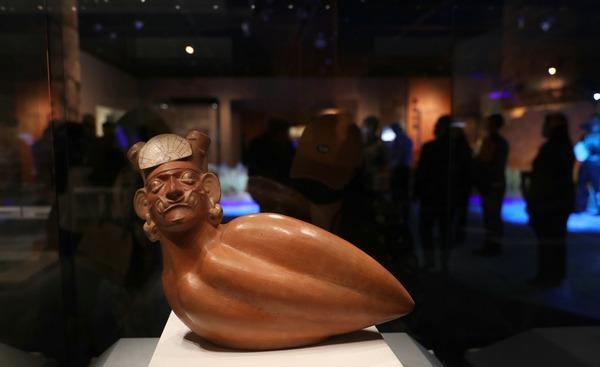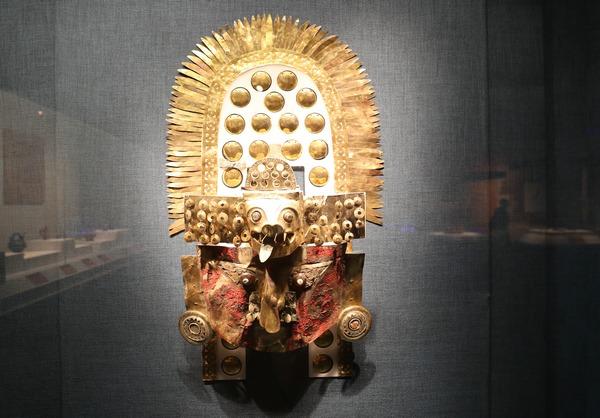 This undated phot shows a pottery vessel in the shape of a squash with a fanged head from the Moche Culture (250-750). (PHOTO / CHINA DAILY)
This undated phot shows a pottery vessel in the shape of a squash with a fanged head from the Moche Culture (250-750). (PHOTO / CHINA DAILY)
From the magnificent Nazca Lines spread across the Pampa Colorada to the mountainous city of Machu Picchu, the world-famous heritage sites in Peru have a lasting attraction for Chinese history buffs with an interest in ancient civilizations.
Though COVID-19 may have temporarily restricted curious Chinese travelers' ability to admire these wonders in person, a newly opened exhibition in Beijing enables them to view the cultural splendor of these historic sites from the other side of the world.
Perhaps, Wonders: the Ancient Andean Civilization in Peru, which is to run through Aug 22 at the Capital Museum in Beijing, is like a panoramic and vividly told story, reviewing the saga of Peruvian civilization that spans three millennia. It is also the first exhibition from abroad that is being held in the museum since the outbreak of the pandemic.
From the Cupisnique Culture dating back to about 1500 BC to the fall of the Inca Empire in the 16th century, 155 highlighted artifacts, including colorful pottery, gold decorations, fabrics and stone carvings, are presented for visitors to reflect the wide time span. They are on loan from 11 museums all over Peru.
According to Zhao Yazhuo, a curator of the exhibition from the Capital Museum, the artifacts cover 15 of the most important cultures throughout the history of ancient Peru.
Peru was a key cradle of civilization along the Andes, and different cultures mixed and boomed in the area.
Zhao Yazhuo, Curator of the exhibition from the Capital Museum
ALSO READ: Peru opens Machu Picchu for a single tourist after 7-month wait
"Peru was a key cradle of civilization along the Andes, and different cultures mixed and boomed in the area," Zhao says. "We want to show how ancient Peruvians lived through the collection of artifacts."
To better explain a remote civilization to the Chinese public, animal patterns on the artifacts are highlighted to provide hints.
For example, worship of felines as totems can be seen in the artifacts from the Chavin Culture from 1300 to 200 BC. Even a ceramic bottle with a human facial decoration has had a pair of buckteeth added to resemble a jaguar.
As Zhao points out, the Chavin Culture represents the first peak of Andean civilization. Many of its features like jaguar worship and large-scale ceremonial centers continued to appear throughout subsequent cultures.
Its fall also marks a long epoch, witnessing rise of various cultures in different regions.
In the Nazca Culture, which lasted roughly from 100 BC to AD 700, orcas were treated like a god. In its mythology, the orca-deity was responsible for taking beheaded prisoners of war to the underworld and thus feed people's ancestors. While in the Moche Culture, lasting from 250 to 750, deer was considered to connect people with the souls of their ancestors, while the magnificent Andean condor also played a key role in its belief system. These traditions are reflected through the exquisite artifacts on display.
Llamas, spiders, bats, and many other animal species which appear in the decorations and patterns of the artifacts, also unveil the complex system of rituals throughout the region's history. Behind these cute animal patterns, the Andes witnessed a succession of cultures that formed the brilliant Peruvian civilization through their mutual communication and their creativity.
For example, the Sican Culture (750-1375) in the north of Peru is famed for its highly developed metallurgy and irrigation agriculture while the Tiwanaku Culture (500 BC-AD 1100) near Lake Titicaca also rose as an economic hub, known for its wide footprint in southern Peru and its inclusiveness toward various cultural elements.
In the late 15th century, Incas established their mighty empire and became the largest political entity ever established by an indigenous population in the Americas before European colonists conquered the continent.
Zhao says the Inca Empire inherited many key traditions of previous cultures, and also showed their creativity in architecture, textiles, pottery and social governance.
Huang Xueyin, deputy director of the Capital Museum and a history researcher, says: "Peru is so far away from China, but ancient civilization in the two countries once met similar questions, like how to get along with natural conditions and how to develop agriculture. Learning each other's experiences can give us better understanding of our own history."
As she points out, some exhibits also show the dedication of cultural relic conservators. Several large pottery urns were used as funeral objects. They were deliberately broken into pieces before being buried as part of a traditional custom.
Thanks to Peruvian restorers' efforts, the pieces have been put back together and now display the complete and exquisite decorative patterns.
Izumi Shimada, a Japanese archaeologist with Southern Illinois University, is the chief curator of the exhibition. The scholar, known for his studies of Andean civilization, likes to keep an open mind about organizing the tour display.
As he mentions during his introduction of the exhibition, archaeological findings are the only things people can rely on to reestablish the history of Andean civilization because there was no textual recording, and some previous conclusions of research can be proved wrong by new findings.
Before the exhibition came to Beijing, since September 2019, it had toured five other provincial-level museums in Shanxi, Tianjin, Chongqing, Hunan and Guangdong.
 This undated photo shows a gold ceremonial dress from the Sican Culture (750-1375). (PHOTO / CHINA DAILY)
This undated photo shows a gold ceremonial dress from the Sican Culture (750-1375). (PHOTO / CHINA DAILY)
READ MORE: Famed Peru restaurant pays price for special 'ladies' menu'
According to Huang, the Capital Museum was not in the initial schedule of the tour, but the outbreak of COVID-19 reshuffled the original plan.
As this year marks the 50th anniversary of the establishment of diplomatic ties between China and Peru, this extra session in Beijing becomes a gift for the celebration of that milestone. Many stories and background information have been added to better explain the Peruvian artifacts to visitors to the Beijing museum.
"People along the Andes faced many difficulties brought about by geological conditions, but that varied landscape is also the base that nurtured such cultural diversity," says Luis Quesada, Peruvian ambassador to China.
"The experiences left by the native people living on the land of today's Peru has helped us to realize the importance of communication and exchange among different civilizations."


